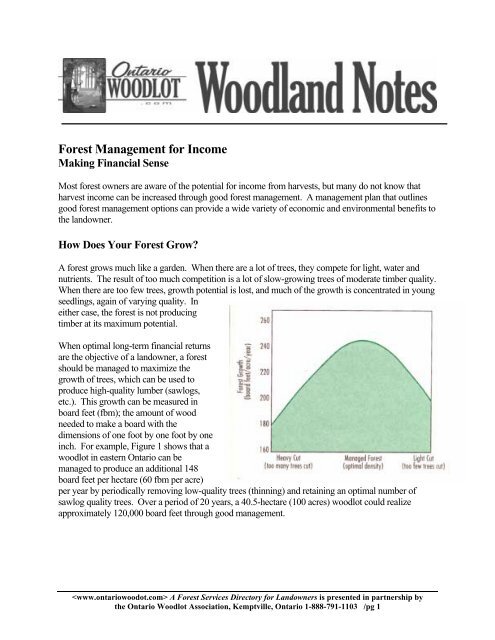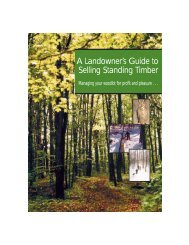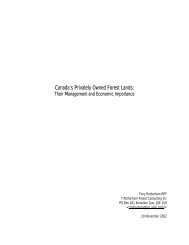Forest Management for Income - Ontario woodlot.com
Forest Management for Income - Ontario woodlot.com
Forest Management for Income - Ontario woodlot.com
You also want an ePaper? Increase the reach of your titles
YUMPU automatically turns print PDFs into web optimized ePapers that Google loves.
<strong>Forest</strong> <strong>Management</strong> <strong>for</strong> <strong>In<strong>com</strong>e</strong>Making Financial SenseMost <strong>for</strong>est owners are aware of the potential <strong>for</strong> in<strong>com</strong>e from harvests, but many do not know thatharvest in<strong>com</strong>e can be increased through good <strong>for</strong>est management. A management plan that outlinesgood <strong>for</strong>est management options can provide a wide variety of economic and environmental benefits tothe landowner.How Does Your <strong>Forest</strong> Grow?A <strong>for</strong>est grows much like a garden. When there are a lot of trees, they <strong>com</strong>pete <strong>for</strong> light, water andnutrients. The result of too much <strong>com</strong>petition is a lot of slow-growing trees of moderate timber quality.When there are too few trees, growth potential is lost, and much of the growth is concentrated in youngseedlings, again of varying quality. Ineither case, the <strong>for</strong>est is not producingtimber at its maximum potential.When optimal long-term financial returnsare the objective of a landowner, a <strong>for</strong>estshould be managed to maximize thegrowth of trees, which can be used toproduce high-quality lumber (sawlogs,etc.). This growth can be measured inboard feet (fbm); the amount of woodneeded to make a board with thedimensions of one foot by one foot by oneinch. For example, Figure 1 shows that a<strong>woodlot</strong> in eastern <strong>Ontario</strong> can bemanaged to produce an additional 148board feet per hectare (60 fbm per acre)per year by periodically removing low-quality trees (thinning) and retaining an optimal number ofsawlog quality trees. Over a period of 20 years, a 40.5-hectare (100 acres) <strong>woodlot</strong> could realizeapproximately 120,000 board feet through good management. A <strong>Forest</strong> Services Directory <strong>for</strong> Landowners is presented in partnership bythe <strong>Ontario</strong> Woodlot Association, Kemptville, <strong>Ontario</strong> 1-888-791-1103 /pg 1
The Benefits of ThinningThinning or improvement cutting is the removal of low-quality trees to increase the amount of light,water and nutrients available to the remaining trees. Thinning results in an increased growth rate of theremaining trees. If these trees have been selected to remain because of their timber potential, thisincrease in growth provides an investment return to the landowner.Trees between 30 cm and 50 cm in diameter in a managed <strong>for</strong>est can easily grow 5 cm in diameterevery 10 years. At this rate, they almost double in value every 10 years because:1. They are growing large amounts of high-value wood suitable <strong>for</strong> lumber, and2. The quality of the lumber, as reflected in log grade, is improving.Not only are the trees accumulating board feet rapidly; the price per board foot in the tree is alsoincreasing.Landowner OptionsMost <strong>for</strong>ests in southern <strong>Ontario</strong> are managed using either a diameter limit system or based on a <strong>for</strong>estmanagement prescription. Under a diameter limit cut, all trees above a preset diameter (usually 30 cm)at chest height are cut. Under a <strong>for</strong>est management prescription, specific trees are selected to be cut orleft, based on their growth potential or their benefit to natural regeneration or wildlife. This selectionprocess is based on many individual tree characteristics, not just tree size. Each tree to be cut is markedwith paint (usually yellow) to ensure that the prescription is followed.There are five good reasons to follow a <strong>for</strong>est management prescription vs. a diameter limit cut.Financial Returns – diameter limit cutting reduces the long-term financial benefits that can be derivedfrom a managed <strong>woodlot</strong>. Under this system, most trees greater than 30 cm in diameter are harvested.Many of these trees would respond well to thinning and could produce a very high rate of return to thelandowner if left to grow to maturity.Future Growth – the thinning provided by a diameter limit cut is not uni<strong>for</strong>m. It is simply a result ofcutting where there are large trees. As a result, some areas of the <strong>for</strong>est which had large trees are cutheavily, while other areas of small trees are not cut at all.In the uncut areas, the <strong>for</strong>est will continue to grow slowly because of overcrowding, and the financialbenefits of thinning will not be achieved. Poor quality, small diameter trees with no potential todevelop into sawlogs should be cut and removed from the <strong>for</strong>est to increase growth of the remainingtimber-quality trees. In most areas of the province there are markets <strong>for</strong> fuelwood and pulpwood topermit sale of these smaller trees.In areas that are cut too heavily, there will be insufficient large trees to capture the increased light,moisture and nutrients available from thinning. As a result, growth will occur largely on youngseedlings. In addition, those trees which remain behind may not be of high sawlog potential. Thelumber-producing capability of the <strong>for</strong>est will be reduced significantly. A <strong>Forest</strong> Services Directory <strong>for</strong> Landowners is presented in partnership bythe <strong>Ontario</strong> Woodlot Association, Kemptville, <strong>Ontario</strong> 1-888-791-1103 /pg 2
Heavy cutting also results in a loss of potential value of the smaller but high-value trees, which are leftbehind. Trees less than 30 cm in diameter tend to have branches located low on the stem. In an uncutor managed <strong>for</strong>est, a sufficient number of trees are present to shade these young trees, causing the lowerbranches to fall off due to a lack of sunlight. This will result in an increase in the “clear length” of thetree over time (the length of the bole with no branches), with a resulting increase in high-quality, knotfreelogs <strong>for</strong> lumber. After a heavier cut, these small trees are exposed to much more sunlight. As aresult, they tend to keep their lower limbs and lose the potential to develop further clear length. In fact,many trees may develop new branches on the trunk after heavy cutting, which actually will reduce theirclear length and future value.<strong>Forest</strong> Regeneration – a <strong>for</strong>est management prescription can be prepared to ensure that a new <strong>for</strong>est ofdesirable species grows after cutting. For instance, sufficient red oak and white pine trees can be left<strong>for</strong> seed and cover to enhance the regeneration of high-value oak and pine seedlings. In a diameter limitcut, the <strong>for</strong>est generally regenerates to whatever young trees are present on the <strong>for</strong>est floor at the time ofcutting. Such procedures rarely result in the regeneration of an oak or pine <strong>for</strong>est. On the contrary, theopen conditions, resulting from heavy cutting, often favor the regeneration of low-value timber specieslike poplar.Wildlife Values – landowners may wish to leave some trees in their <strong>for</strong>est to provide high-qualitywildlife habitat (including nesting sites, mast and cover). These values must be addressed in the <strong>for</strong>estmanagement prescription.Tree-Cutting Bylaws or Tree Conservation Bylaws – in some municipalities, diameter limit cuttingis a contravention of local tree-cutting bylaws and is not in accordance with good <strong>for</strong>estry practices.Where to Get help – be<strong>for</strong>e beginning harvesting operations in your <strong>woodlot</strong>:✔✔✔✔Prepare a management plan;Check to see if your municipality has a tree-cutting or <strong>for</strong>est conservation bylaw;Consider discussing your harvest activities with a qualified <strong>for</strong>est consultant: andHave your <strong>woodlot</strong> marked by a certified tree markerSuggested ReadingAdditional in<strong>for</strong>mation relating to selection cutting and managing your <strong>woodlot</strong> <strong>for</strong> sawlogs is availableon-line at from the LandOwner Resource Centre. Or you can obtain copies ofthese extension notes from the LRC by calling (613) 692-2390.You may find the extension notes listed below helpful.Managing Young Hardwood Stands <strong>for</strong> Sawlog ProductionChoosing A Silviculture System<strong>Forest</strong>ry Talk: A Glossary of Common Terms© 2003, <strong>Ontario</strong> Woodlot Association A <strong>Forest</strong> Services Directory <strong>for</strong> Landowners is presented in partnership bythe <strong>Ontario</strong> Woodlot Association, Kemptville, <strong>Ontario</strong> 1-888-791-1103 /pg 3
















